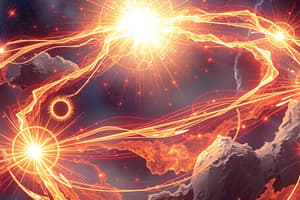Podcast
Questions and Answers
Which force is responsible for holding protons and neutrons together in an atomic nucleus?
Which force is responsible for holding protons and neutrons together in an atomic nucleus?
- Gravitational Force
- Strong Nuclear Force (correct)
- Electromagnetic Force
- Weak Nuclear Force
What is the formula for calculating kinetic energy?
What is the formula for calculating kinetic energy?
- KE = mv
- KE = mgh
- KE = Fd
- KE = 1/2 mv² (correct)
Which of Newton's Laws states that an object will remain at rest unless acted upon by a net force?
Which of Newton's Laws states that an object will remain at rest unless acted upon by a net force?
- Law of Universal Gravitation
- Third Law
- First Law (correct)
- Second Law
According to the second law of thermodynamics, what happens to the entropy of an isolated system?
According to the second law of thermodynamics, what happens to the entropy of an isolated system?
Which type of wave requires a medium to travel through?
Which type of wave requires a medium to travel through?
What is the result of light passing through a concave lens?
What is the result of light passing through a concave lens?
What does Ohm's Law relate?
What does Ohm's Law relate?
What aspect of light explains its dual wave-particle nature?
What aspect of light explains its dual wave-particle nature?
Flashcards are hidden until you start studying
Study Notes
Key Concepts in Physics
-
Fundamental Forces:
- Gravitational Force: Attraction between masses.
- Electromagnetic Force: Interaction between charged particles.
- Strong Nuclear Force: Holds protons and neutrons together in the nucleus.
- Weak Nuclear Force: Responsible for radioactive decay.
-
Laws of Motion (Newton’s Laws):
- First Law (Inertia): An object at rest stays at rest, and an object in motion stays in motion unless acted on by a net force.
- Second Law (F=ma): The acceleration of an object is directly proportional to the net force acting on it and inversely proportional to its mass.
- Third Law (Action-Reaction): For every action, there is an equal and opposite reaction.
-
Energy:
- Kinetic Energy: Energy of motion, calculated as KE = 1/2 mv².
- Potential Energy: Stored energy due to position, typically gravitational PE = mgh.
- Conservation of Energy: Energy cannot be created or destroyed, only transformed.
-
Thermodynamics:
- First Law: Energy conservation; energy cannot be created or destroyed.
- Second Law: Entropy of an isolated system always increases; heat flows from hot to cold.
- Third Law: As temperature approaches absolute zero, the entropy of a perfect crystal approaches zero.
-
Waves and Sound:
- Wave Properties: Wavelength, frequency, amplitude, and speed.
- Types of Waves: Mechanical (requires medium) and Electromagnetic (can travel through a vacuum).
- Sound: Longitudinal wave that travels through air, characterized by frequency (pitch) and amplitude (loudness).
-
Light and Optics:
- Nature of Light: Electromagnetic radiation that behaves both as a wave and a particle (photon).
- Reflection and Refraction: Change in direction of light when it bounces off surfaces or passes through different media.
- Lenses: Converging (convex) and diverging (concave) lenses manipulate light to form images.
-
Electricity and Magnetism:
- Electric Charge: Fundamental property that causes electric interactions; positive and negative charges.
- Ohm's Law: V = IR, where V is voltage, I is current, and R is resistance.
- Magnetism: Magnetic fields result from moving electric charges; magnets have north and south poles.
-
Modern Physics:
- Relativity: Einstein’s theories of special and general relativity revolutionized the understanding of space, time, and gravity.
- Quantum Mechanics: Study of particles at the atomic and subatomic levels, involving wave-particle duality and uncertainty principle.
-
Applications of Physics:
- Technology: Development of devices like cameras, lasers, and electronics.
- Engineering: Application of physics principles in designing structures, vehicles, and machinery.
- Medicine: Use of physics in imaging techniques (e.g., X-rays, MRI) and radiation therapy.
-
Measurement in Physics:
- SI Units: Standard units for measurement (e.g., meter for length, kilogram for mass, second for time).
- Precision and Accuracy: Importance of measurements in experiments and data analysis.
These notes cover fundamental principles and concepts in physics, providing a concise overview for study and review.
Fundamental Forces
- Gravitational Force: Attraction between masses; governs planetary motion.
- Electromagnetic Force: Interaction involving charged particles; responsible for electricity and magnetism.
- Strong Nuclear Force: Binds protons and neutrons in atomic nuclei; essential for nuclear stability.
- Weak Nuclear Force: Mediates radioactive decay; plays a crucial role in nuclear reactions.
Laws of Motion (Newton’s Laws)
- First Law (Inertia): Objects maintain their state of rest or uniform motion unless influenced by an external force.
- Second Law (F=ma): Indicates that an object's acceleration is proportional to net force and inversely proportional to its mass.
- Third Law (Action-Reaction): States that every action results in an equal and opposite reaction, highlighting the interaction between forces.
Energy
- Kinetic Energy: Energy associated with motion, calculated using KE = 1/2 mv², illustrating the relationship between mass and velocity.
- Potential Energy: Energy stored due to an object's position; commonly gravitational, expressed as PE = mgh.
- Conservation of Energy: Principle stating energy cannot be created or destroyed but can change from one form to another.
Thermodynamics
- First Law: Conservation of energy principle; energy transfer between systems does not create or destroy energy.
- Second Law: Entropy in isolated systems increases over time; thermal energy naturally flows from hot to cold areas.
- Third Law: As systems approach absolute zero, the entropy of a perfect crystal tends to zero.
Waves and Sound
- Wave Properties: Key characteristics include wavelength (distance between peaks), frequency (number of waves passing a point), amplitude (height of wave), and speed.
- Types of Waves: Mechanical waves require a medium (e.g., sound), while electromagnetic waves can travel through a vacuum (e.g., light).
- Sound Waves: Longitudinal waves characterized by pitch (frequency) and loudness (amplitude), traveling through air and other mediums.
Light and Optics
- Nature of Light: Exhibits dual properties of wave and particle (photon), allowing various phenomena like interference and reflection.
- Reflection and Refraction: Light altering direction upon bouncing off surfaces (reflection) or passing through different media (refraction).
- Lenses: Convex lenses converge light to focus images, while concave lenses diverge light, used in various optical devices.
Electricity and Magnetism
- Electric Charge: Fundamental property that leads to electric forces; exists as positive or negative charges.
- Ohm's Law: Relationship between voltage (V), current (I), and resistance (R); fundamental for analyzing electrical circuits.
- Magnetism: Arises from electric charges in motion; all magnets have north and south poles, creating magnetic fields.
Modern Physics
- Relativity: Einstein's theories revolutionizing concepts of space, time, and gravitational effects, impacting understanding of the universe.
- Quantum Mechanics: Focus on behavior of particles at atomic levels; introduces concepts such as wave-particle duality and the uncertainty principle.
Applications of Physics
- Technology: Innovations include cameras, lasers, and electronics, relying on physical principles for functionality.
- Engineering: Incorporation of physics principles in the design and construction of structures, machinery, and transportation systems.
- Medicine: Application of physics in diagnostic imaging (e.g., X-rays, MRI) and treatment modalities such as radiation therapy.
Measurement in Physics
- SI Units: Internationally recognized metric system for consistent measurements (meter for length, kilogram for mass, second for time).
- Precision and Accuracy: Critical for effective experimentation and data analysis, ensuring reliable and repeatable results in physical studies.
Studying That Suits You
Use AI to generate personalized quizzes and flashcards to suit your learning preferences.




